UK music festivals now offer a host of high-end food and drink options and imaginative activations. So how are the most successful partnerships conceived and executed?
Music festival grub used to involve questionable burgers from vans, washed down with a lukewarm can of Red Stripe. But, as ticket prices have rocketed, a quiet culinary revolution has taken place. Rather than dodgy vans, festivalgoers are now more likely to encounter a pop-up Co-op store or Veuve Clicquot ‘champagne garden’.
“Food and drink has become an integral part of the festival-going experience,” says Emma Pyle, senior brand activation manager at Thatchers Cider. “It’s often as important as who’s headlining the main stage nowadays. Festivalgoers have come to expect high-end food and drink experiences.”
So, as summer looms, how important will festivals be to food and drink brands this year? What activations are brands working on? How do both sides choose who to partner with, and what does a successful partnership look like?
For challengers, the brand-building power of the UK’s £3.5bn festival scene can be immense. Pieminister is a case in point. The brand had been selling pies from its small bakery and shop in Bristol for just six months when it pitched up at Glastonbury Festival in 2004.
“The customers had never seen anything like it,” remembers Jon Simon, co-founder & MD at Pieminister. “It was a major catalyst for Pieminister’s future success. We went on to cater at over 30 festivals and events the following summer, and then 50 every year until 2019.
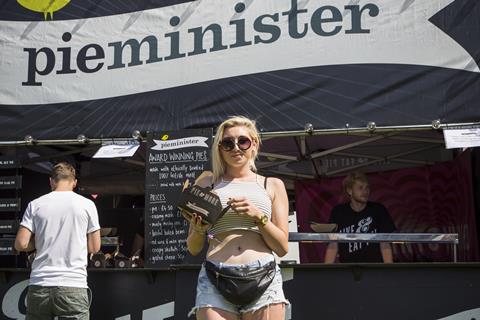
Festivals were then put on the back-burner with the onset of the pandemic – but the effects are still clear to see. “Four years after our first festival, we got our first supermarket listing, launching into Waitrose, bringing a new, younger consumer from the festival fields into the pie aisles,” Simon says.
Interesting smaller brands such as Pieminister offer something to festival organisers, too, according to Will Dowdy. He’s vice-president of global partnerships at AEG Presents, which puts on festivals including All Points East, Lido and BST Hyde Park.
“Festivals are all about discovery, so although there’s always a place for quality, established F&B brands that people know and trust, there’s increasing demand for new and emerging products that can provide something exciting,” he says.
Take All Points East, which has pioneered entirely new drink formats. It started working with US seltzer brand White Claw in 2021, “before they became a household name”. The festival also partnered with soju brand Jinro in 2023, before it had gained distribution in the UK.
“Not only was the brand absolutely new to people, many were totally unfamiliar with the entire category,” says Dowdy. “But we were confident the All Points East audience would love to be ahead of the crowd and act as tastemakers and micro influencers.
“Launching new products at [our festivals] … is a unique opportunity to build brand love in the UK by engaging with an affluent, open-minded crowd.”
Of course, the appeal of festivals isn’t confined to challenger brands. Drinks giant Diageo will be attending about 20 this year across the country. Smirnoff head of marketing Jessica Lace is most excited by the “positive and explorative mindset” of festivalgoers.
“It’s a great opportunity to encourage consumers to try some of our new products,” she says, citing recently launched Diageo RTDs such as Captain Morgan & Pepsi Max and Smirnoff Miami Peach.
Bio&Me
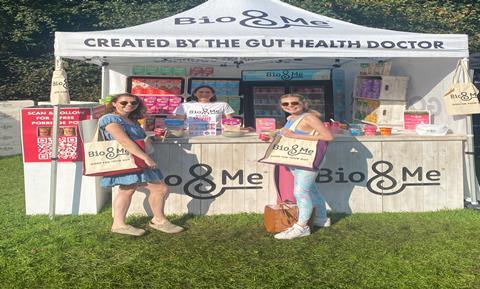
Gut health brand Bio&Me will be extolling the benefits of good gut health to nearly 100,000 consumers this summer.
Coupons for its products – which boast an in-store redemption rate of around 6% – are a key part of all its festival activity. But that’s not all.
This year, the brand will show up at Taste of London with a granola & yoghurt station – plus a kefir shot bar offering a healthy twist on slamming alcoholic shots.
Bio&Me will also return to CarFest for a fifth year with its porridge pots, while co-founder Dr Megan Rossi will take to the stage to deliver talks on gut health.
Visitors across all events will be able to enjoy interactive games and prizes, including a buzzwire challenge and the chance to win lots of “gut-tastic prizes”.
“We’re really excited about RTDs and the role they can play in festivals in terms of speed of service, offering a perfect serve, being easy to carry around and often quite affordable as well.”
Thatchers also sees festivals as “a natural fit” for the brand, Pyle says. The cider will be at more than 35 this year, and is particularly enthused by the sampling opportunity.
“Nothing beats getting out there and meeting customers face to face,” she says. “You get honest insights you just can’t capture through market research alone.”
The right partnerships
Not that those insights come easy. Striking up a partnership is a long, carefully thought out process. In terms of who approaches who, it’s a mixed bag.
“Sometimes, a partner will approach us with an idea that instantly clicks, making perfect sense for the festival. From there, we get to enjoy the creative process of bringing it to life in a festival setting,” says Emma Kirkby, event manager at Wilderness Festival in Oxfordshire. “Other times, we already have a concept in mind and reach out to partners we believe would be the perfect fit, hoping they see the value in it too – which, happily, they often do,” she says.
On AEG’s festivals, key categories such as beer and cider usually go out to tender, Dowdy says. For other categories, the company taps existing industry relationships to understand which F&B categories and brands are trending, and then makes a direct approach.
Regardless of who makes the first move, there are several factors to consider before signing an agreement. First, the ethos has to be the right fit for both the brand and the festival. When the two align, the results can be well worth the effort.
For example, this summer Pieminister is attending Shambala in Northamptonshire, a fiercely independent event that only allows vegetarian food stalls. It’s a golden opportunity for the pie brand to show off its vegan chops to a highly engaged audience.
The choice reflects a careful strategy at Pieminister, which only chooses festivals that align with its ethical and sustainability standards, says Simon.
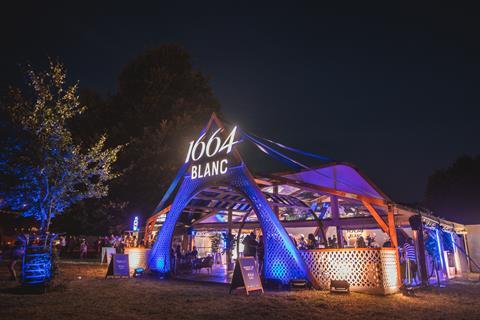
The festivals themselves can be equally choosy. Wilderness is arguably more associated with quality food and drink than any other festival – the result of carefully considering its partners.
“We’re always looking for partners who share our ethos when it comes to delivering exceptional experiences,” says Kirkby.
“It’s a delicate balance between bringing back beloved favourites that our audience knows and loves, while also introducing fresh, innovative elements. This could be through new partners or new concepts and experiences.”
Alongside that shared vision, location is another key factor to consider when entering a partnership. Given Thatchers’ roots in Somerset, it makes an effort to show up as often as possible for events in the West Country, says Pyle. However, it’s also keen to reach audiences further afield, at festivals like Kendal Calling, Tramlines and Y Not.
“The focus isn’t just on profit from the event, it’s on building meaningful connections”
Emma Pyle, Thatchers Cider
Demographics are another important consideration. Most festivals over-index with a younger audience of LPA (legal purchasing age) up to about 34.
But it’s not always that simple. Some events will attract different demographics every day, depending on the lineup. BST Hyde Park, for example, will be welcoming very different festivalgoers for Sabrina Carpenter’s headline slots on 5 and 6 July, compared to when Neil Young rolls in the following weekend.
That makes the partnership between Asahi and BST Hyde Park a great fit, says Dowdy.
“Asahi UK has such a breadth of super premium and accessible brands that they can provide flexibility, while the festival enables them to showcase their diverse portfolio to multiple key audiences,” he says.
Diageo has a similarly diverse portfolio of brands – and so carefully considers which to place in which events. Smirnoff and Captain Morgan – which also over-index on younger drinkers – tend to lean towards ‘younger’ events like Boardmasters in Newquay.
“Whereas, for a brand like Johnnie Walker, we’d be looking at a more affluent audience who are a bit more discerning – Wilderness or Lost Village are examples of festivals where we see more of those people,” says Lace.
Deciding on the right partner, of course, is just the start. The entire process takes “months and months and months”, Lace adds.
“It’s a bit like Christmas. As soon as festival season’s over, everyone’s already planning for the next one. It’s a bit of an ongoing cycle really.”
From signup to champagne bars
As a starting point, festivals will work with brands to decide what will be included in the deal.
The price of a festival partnership can vary massively, from “a few hundred pounds for a local community event to tens of thousands”, according to Simon. Fees will also vary depending on the location of the pitch, pouring rights and the use of additional support such as social media package.
Support can be “as comprehensive as designing and creating their activations on site and acting as a 360 agency”, Dowdy says. “This is particularly helpful for emerging brands with limited agency support.”
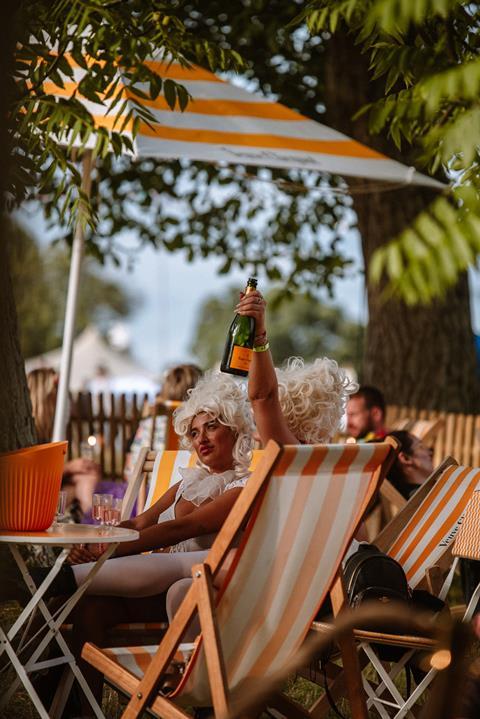
Once the deals are signed, the goal is to create an activation that ticks the right boxes for both the brand and the festival. The number of approaches is almost endless, and they can be a hotbed of complexity and creativity.
Wilderness has hosted everything from hidden workshops to treasure hunts leading to a ‘secret garden’, Kirkby recalls. Another favourite was Veuve Clicquot’s returning champagne garden, which overlooks a lake and hosts DJs, a bistro terrace and a sun deck.
Then there’s 1664 Blanc’s “eye-catching yet elegant” space, where festivalgoers can sip on the premium French beer.
At AEG, Dowdy points to The Kraken rum’s Freaky Tiki bar at All Points East as an activation that’s consistently “delivered a great experience” for the past six years. That’s thanks to its “high production values” and decision to collaborate with the festival to tailor its music to each day of the event.
Different activations, different events
The type of activation required will depend heavily on the event. A giant of the festival calendar – like, say, Glastonbury or Reading – might call for something very different to a smaller, boutique affair such as Wilderness or Bearded Theory. And that will be different again from the uber-local mini festivals taking place in towns up and down the country.
“Big events mean bigger stalls, more people and far more pies to sell,” says Simon. “The local community events are great fun, easy to activate and a great way to engage with people face to face and learn first-hand what they think of the pies and the brand.
“These events give us great ideas for new products and how we can improve existing ones as well.”
Thatchers similarly “tailors our activities so they’re bespoke to each festival depending on size and scale”, says Pyle. This year, it will stage immersive activations such as the Thatchers Balloon Bar and the Land Rover bar.
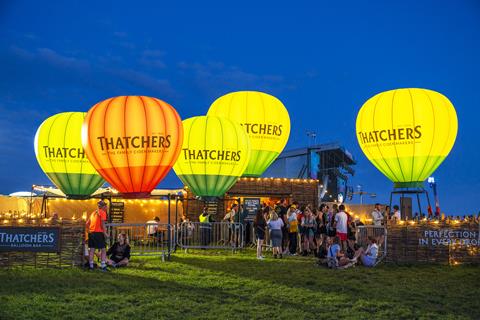
Thatchers
This year, cider expert Thatchers will be turning up at more than 35 festivals, from Tramlines to Truck Festival and Tunes in the Dunes, with a range of immersive activations.
First there’s the brand’s hot air balloon bar, which will visit Victorious, Boardmasters and Y Not. Featuring replica hot air balloons and wicker basket seats, this year the brand has added “stylish selfie points” as well as competitions and sampling. Last year, the brand also launched its live DJ bar, adding hot new DJs to the mix.
Then there are the “crowd favourite Land Rover bars”, says Emma Pyle, senior brand activation manager at Thatchers.
“Once parked up, the converted Land Rovers are surrounded by their own cider garden, offering visitors the chance to enjoy their pint in a true Somerset setting, no matter where they are in the country.”
At Diageo, Lace reveals Casamigos tequila has been going down well in festival VIP areas. At Boardmasters, for example, it was served from its own separate bar in a range of frozen margarita cocktails, “which was very successful”.
“We obviously focus on ensuring we give consumers a great experience with our products. But secondly, in terms of the activation or experience, what we really want to do is enhance people’s festival experience. We don’t want to distract,” she says.
“So it’s things like DJ sets when there’s no one on the main stage. How can we improve the camping experience? How can we help people get a drink that’s properly cold?” she says. “Festivals can be challenging for people, so we’re trying to think about ways we can really, truly add value.”
The need for cold drinks and “perfect serves” brings Lace to the opportunity of RTDs.
At BST Hyde Park last summer, she says, Diageo saw “huge success” in general but particularly with RTD cans. According to the brand, Smirnoff Raspberry Crush was its most popular seller over the festival’s 17 days, making up 33% of all Diageo’s RTD sales.
Fmcg and festivals in numbers
- 44% of festivalgoers identified food and drink deals as the top area needing improvement
- £3.5bn is the total estimated value of the UK music concerts and festivals market
- 58% of people go to festivals with no set budget in mind
- 23% of attendees expressed interest in trying cocktails at festivals if they were more portable and convenient
The definition of success
Beyond product sales, the bigger question is what makes a successful festival partnership overall.
The answer depends on who you’re asking. For Thatchers, “it’s about more than just what happens at the event”, Pyle says.
After all, people will remember their festival experiences for years to come. So being able to “add value to those special moments through authentic brand activation can build long-term brand love and loyalty”, she points out. “The focus isn’t just on profit from the event, it’s about building meaningful connections.”
That’s a critical point of view, considering returns from festivals can be “volatile”, says Pieminister’s Simon. They can depend on factors as unpredictable as the weather, to whether ticket sales match predictions, the location of the stall, whether there’s overnight camping and more.
For him, daily sales of 500 to 1,000 Pieminister meals would be considered a success, while returns from each festival “can range from a loss to a few thousand pounds”.
So for most brands that frequent festivals, the bigger picture of penetration is also key. Recruiting consumers that may not have tried their brand before, with a view to them buying the product in their daily lives, is undoubtedly a win.
That ties in with the longer-term piece, which Lace says “is really important from a brand equity perspective”.
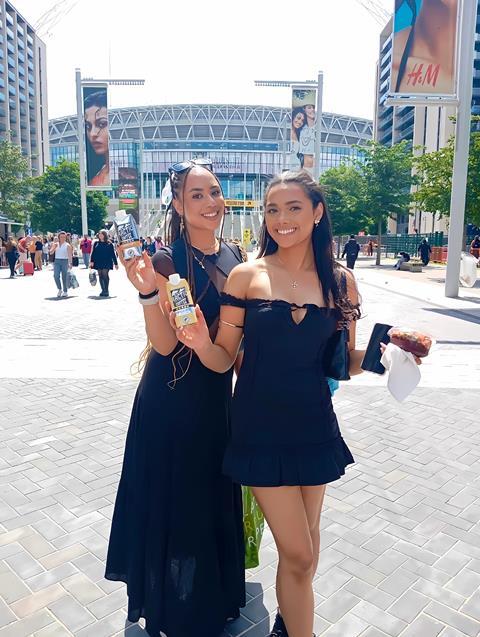
Arctic Coffee
This summer, Arctic Coffee will be showing up at festivals and concerts across the UK – but not in the way you’d expect.
Steering clear of “the typical big-brand presence”, Arctic is taking a guerrilla approach, offering samples to consumers in unexpected places. “Instead of setting up inside festival grounds with inflated prices and branded tents, we’ll be just outside the action – handing out chilled Arctic Coffees for free,” says the brand.
They’re also teaming up with car manufacturer Isuzu, which will be supplying a rugged, Arctic Coffee-branded truck. The aim is to power the mission of “turning up authentically, adding genuine value to consumers’ key summer memories”.
That involves “thinking about how us being there at such an important experience for consumers enables us to build meaningful connections around their passion points. And that’s a harder thing to measure, obviously, because it’s longer term. It’s not something you see overnight,” she points out.
From the perspective of the festivals, on-site engagement is a huge factor, according to Kirkby at Wilderness. “Did it sell out? How busy was it? Beyond that, feedback is key. We look at real-time reactions from customers, particularly in more intimate experiences where they can share one-on-one feedback with the hosts, chefs or brands.”
Wilderness also sends out post-festival surveys to attendees to gather even more feedback about food and beverage partnerships and “always takes their responses on board”.
Dowdy says AEG’s festivals also have a “blunt sales metric to assess”, though he adds that he uses the term ‘blunt’ because “the volume expectations for, say, an established lager brand would very likely exceed a new RTD cocktail brand introducing itself into the UK”.
AEG also works ahead of the event to establish a brand’s KPIs, whether it’s increased awareness, favourability, or propensity to purchase. Those figures can offer an objective gauge of success.
Again, though, what can’t be measured is the “magic” created when a “brilliantly executed” activation or partnership “comes together with someone’s best day out of the year”, Dowdy says.
“A truly successful partnership creates lasting brand connections,” he adds. “It’s when a festivalgoer, walking the supermarket aisle on a wet Tuesday evening in February, recalls a brand and makes a purchase with a smile.”

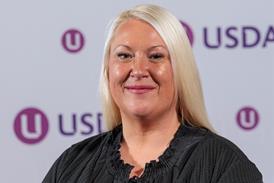
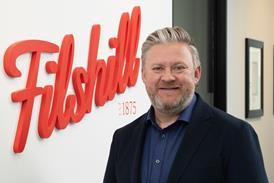
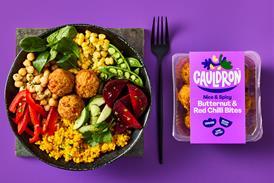
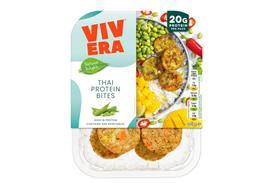
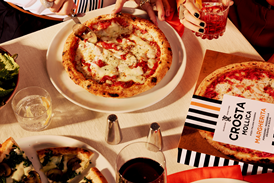

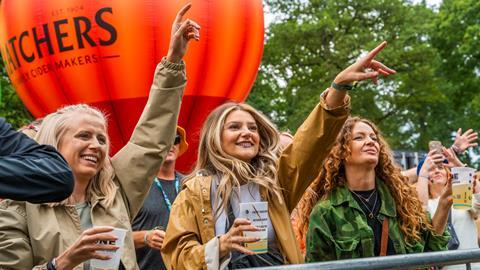
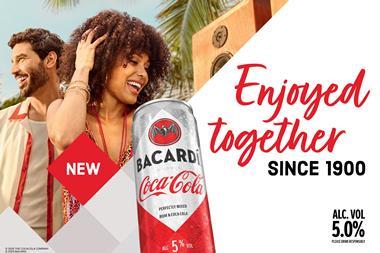
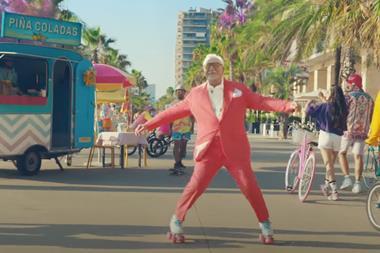
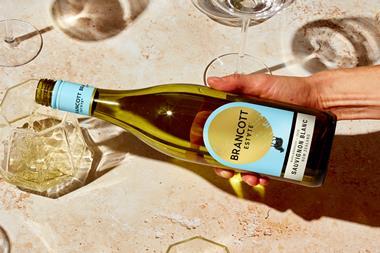

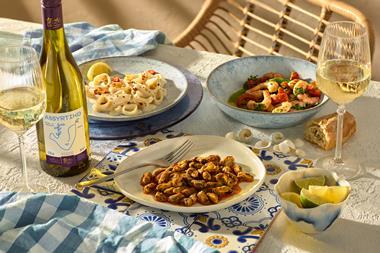



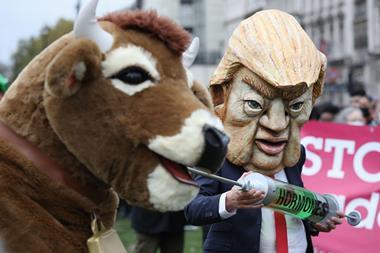

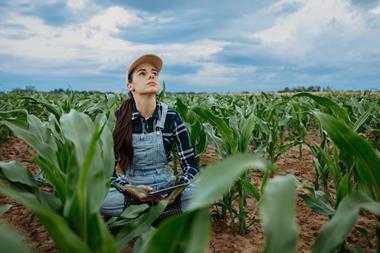
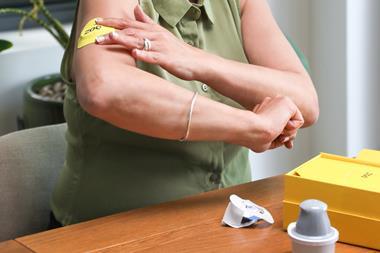
No comments yet